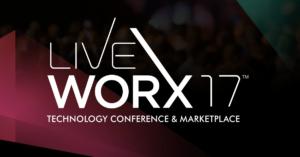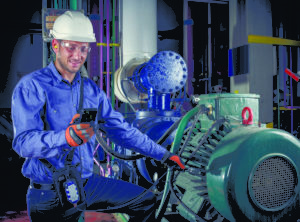Let’s not forget: human workers can and must still pay a role in the IoT!
Sure, the vast majority of IoT focus is on large-scale precision and automated manufacturing (Industrie 4.0 as it is known in Germany, or the Industrial Internet here). However, an ingenious local startup, Tulip, is bringing IoT tools to the workbench and shop floor, empowering individual industrial engineers to create no-code, low-code apps that can really revolutionize things in the factory. Yes, many jobs will be replaced by IoT tech, but with Tulip, others will be “enabled” — workers will still be there to make decisions, and they’ll be empowered as never before.
Um, I’m thinking superhuman factory Transformers, LOL!
The Tulip IoT gateway allows anyone to add sensors, tools, cameras and even “pick to light bins” (never heard that bit of shop lingo, but they looked cool in video) to the work station, without writing a line of code, because of the company’s diverse drivers support factory floor devices. It claims to “fill the gap between rigid back-end manufacturing IT systems and the dynamic operations taking place on the shop floor.”
Rony Kubat, the young MIT grad who’s the company’s co-founder is on a mission “to revolutionize manufacturing software,” as he says, because people who actually have to play a hands-on roll in product design and production on shop floor have been ignored in the IoT, and many processes such as training are still paper-based:
“Manufacturing software needs to evolve. Legacy applications neglect the human side of manufacturing and therefore suffer from low adoption. The use of custom, expensive-to-maintain, in-house solutions is rampant. The inability of existing solutions to address the needs of people on the shop floor is driving the proliferation of paper-based workflows and the use of word processing, spreadsheet and presentation applications as the mainstay of manufacturing operations. Tulip aims to change all this through our intuitive, people-centric platform. Our system makes it easy for manufacturers to connect hands-on work processes, machines and backend IT systems through flexible self-serve manufacturing apps”.
While automation in factory floors continues to grow, manufacturers often find their hands-on workforce left behind, using paper and legacy technology. Manufacturers are seeing an enormous need to empower their workforce with intuitive digital tools. Tulip is a solution to this problem. Front-line engineers create flexible shop-floor apps that connect workers, machines and existing IT systems. These apps guide shop-floor operations enabling real-time data collection and making that data useful to workers on factory floors. Tulip’s IoT gateway integrates the devices, sensors and machines on the shop floor, making it easy to monitor and interact with previously siloed data streams (you got me there: I HATE siloed data). The platform’s self-serve analytics engine lets manufacturers turn this data into actionable insights, supporting continuous process improvement.
The company has grown quickly, and has dozens of customers in fields as varied as medical devices, pharma, and aerospace. The results are dramatic and quite varied:
- Quality: A Deloitte analysis of Tulip’s use at Jabil, a global contract manufacturer, documented 10+% production increases. It reduced quality issues in manual assembly by more than 10%. found production yield increased by more than 10 percent, and manual assembly quality issues were reduced by 60 percent in the initial four weeks of operation.
- Training: Other customers reduced the amount of time to train new operators by 90 percent, in a highly complicated, customized and regulated biopharmaceutical training situation: “Previously, the only way to train new operators was to walk them repeatedly through all the steps with an experienced operator and a process engineer. Tulip quickly deployed its software along with IoT gateways for the machines and devices on the process, and managed to cut training time almost by half.”
- Time to Market: They reduced a major athletic apparel maker’s time to market by 50% for hundreds of new product variations. That required constantly evaluating the impact of dozens of different quality drivers to isolate defects’ root causes — including both manual and automated platforms. Before Tulip, it could take weeks of analysis until a process was ready for production. According to the quality engineer on the project, “I used Tulip’s apps to communicate quality issues to upstream operators in real-time. This feedback loop enabled the operators to take immediate corrective action and prevent additional defects from occurring.”
Similar to my friends at Mendix, the no-code/low-code aspect of Tulip’s Manufacturing App Platform lets process engineers without programming backgrounds create shop floor apps through interactive step-by-step work instructions. “The apps give you access through our cloud to an abundance of information and real-time analytics that can help you measure and fine-tune your manufacturing operations,” Tulip Co-Founder Natan Linder says (the whiz-kid is also chairman of 3-D printer startup Formlabs).
Linder looked at analytics apps that let users create apps through simple tools and thought why not provide the same kind of tools for training technicians on standard operating procedures or for building product or tracking quality defects? “This is a self-service tool that a process or quality engineer can use to build apps. They can create sophisticated workflows without writing code…. Our cloud authoring environment basically allows you to just drag and drop and connect all the different faucets and links to create a sophisticated app in minutes, and deploy it to the floor, without writing code,” he says. Tulip enables sharing appropriate real-time analytics with each team member no matter where they are and to set up personal alerts for the data that’s relevant to each.
IMHO, this is a perfect example of my IoT “Essential Truth” of “empowering every worker with real-time data.” Rather than senior management parceling out (as they saw fit) the little amount of historical data that was available in the past, now workers can share (critical verb) that data instantly and combine it with the horse sense that can only be gained by those actually doing the work for years. Miracles will follow!
Writ large, the benefits of empowering shop floor workers are potentially huge. According to the UK Telegraph, output can increase 8-9 %, while cutting costs 7-8%, cutting costs approximately 7-8 percent. The same research estimates that industrial companies “could see as much as a 300 basis point boost to their bottom line.”
Examples of the relevant shop-floor analytics include:
- “Show real-time metrics from the shop floor
- Report trends in your operations
- Send customized alerts based on user defined triggers
- Inform key stakeholders with relevant data”
IDC Analyst John Santagate neatly sums up the argument for empowering workers through the IoT thusly:
“With all of the talk and concern around the risk of losing the human element in manufacturing, due to the increasing use of robotics, it is refreshing to see a company focus on improving the work that is still done by human hands. We typically hear the value proposition of deploying robots and automation of improvements to efficiency, quality, and consistency. But what if you could achieve these improvements to your manufacturing process by simply applying analytics and technology to the human effort? This is exactly what they are working on at Tulip.
“Data analytics is typically thought about at the machine level. Manufacturers measure things such as throughput, efficiency, and quality by applying sensors to their manufacturing equipment, capturing the data signals, and conducting analytics. The analytics provide an understanding of the health of the manufacturing process and enable them to make any necessary changes to improve the process. Often, such efforts are top down driven. Management drives these projects in order to improve the performance of the business. An alternative approach is to enable the production floor to proactively identify improvement opportunities and take action, a bottom-up approach. For this self-service approach to succeed shop-floor engineers need a flexible platform such as Tulip’s, that allows them to replace paper-based processes with technology and build the applications that enable them to manage hands-on processes. The real time analytics and visibility of hands-on manufacturing processes from Tulip’s platform puts the opportunity to identify improvement opportunities directly in the hands of people engaged in the work cells.
“Digital transformation in manufacturing is about leveraging advanced digital technology to improve how a company operates. But, as the manufacturing industry focuses on digital transformation it must not forget the value of the human element. Indeed, we don’t often think about digital transformation in relation to human effort, but this is exactly the sort of thinking that can deliver some of the early wins in digital transformation. “
Well said — and thanks to Tulip for filling a critical and often overlooked aspect of the IoT!
I’m reminded of my old friend Steve Clay-Young, who managed the BAC’s shop in Boston, and first alerted me to the “National Home- workshop Guild” which Popular Science started in the Depression and then played a critical part in the war effort. Craftsmen who belonged all got plans and turned out quality products on their home lathes. I can definitely see a rebirth of the concept as the cost of 3-D printers from Kubat’s other startup, Formlabs drops, and we can have the kind of home (or at least locally-based production that Eric Drexler dreamed of in his great Engines of Creation (which threw in another transformational production technology, nanotech).
I’m clearing space in my own workshop so I can begin production on IoT/nanotech/3-D printed products. Move over, GE.
 Got here a little late for CEO Jim Heppelman’s keynote, so here goes!
Got here a little late for CEO Jim Heppelman’s keynote, so here goes!

